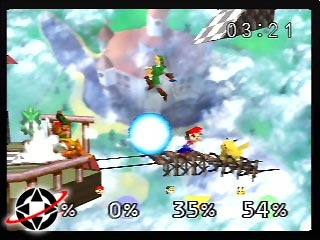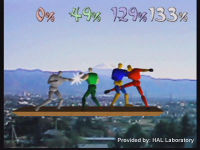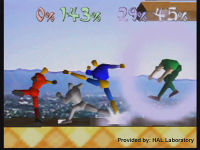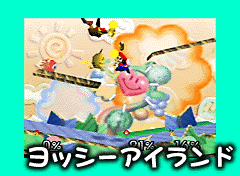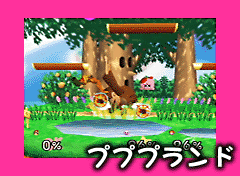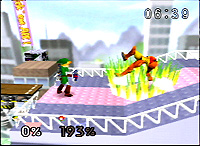The development began in 1998 with the idea of a game where anyone, even those unfamiliar to gaming, would play and appreciate it as anyone would within the first ten minutes of play, and it had to be a very easy way for those who are new to video-games to become more involved with it. To do the task, it had to be "designed to make different things happen simply by pressing random buttons, so some amazing things can happen without even trying," and appropriate for every audience without being simplistic. With that, two people started working on a prototype, that would later become Super Smash Bros..
sites:
http://www.nintendo.co.jp/n01/n64/software/nus_p_nalj/
http://web.archive.org/web/19990427151523/http://www.nintendo.com/n64/smashbrothers/index.html
http://smashboards.com/threads/smash-development-history-updated-1-3.324410/
http://www.nintendo.co.jp/n01/n64/software/nus_p_nalj/smash/Home.html#contents
Kakuto-Geemu Ryuoh
The prototype in question, called Kakuto-Geemu Ryuoh (格闘ゲーム竜王), translating to Dragon King: The Fighting Game, lacking any Nintendo characters. It is referenced to as "Test Version" if Satoru Iwata's name is selected in the game's credits. Unknowing if the game would be well-received by players, the two creators focused on creating a game with four players that utilized the Nintendo 64's joystick, and as an creative alternative to the games of the fighting genre, which were the main reasons for them to develop the project, with the help of one person for the audio.
- The damage meters were placed in the top of the screen, did not change colors as they increased or decreased, lacked the character's stocks and the symbol from their respective series, and the font was very different. Red, green, purple and white were used as the representative colors for Player 1, 2, 3 and 4 respectively, but they were changed to red, blue, yellow and green; the damage meter was used to show these colors, but it was changed to the character's series symbol.
- The background is exclusive to the prototype. It is a picture of Ryuoh-cho, Yamanashi Prefecture, Japan.
- The stage is exclusive to the prototype, though its design has a resemblence to the "How to Play" Stage, only being smaller and having a seemingly mobile platform. The yellow texture used in the main platform is exclusive to the prototype; on it, stands a tiny, texture-less cube.
- When someone is hit by an attack, such as Fireball, PK Thunder, and Spin Attack, an "effect" is shown, which is an aesthetic animation accompanied with an appropriate sound. The effects are exclusive to the prototype. One seems to be an early, completely blank and simpler version of the one used for normal attacks, and the other is a purple circle, never seen in the game.
- The four texture-less characters are exclusive to the prototype, though they have a big resemblence to Captain Falcon, two of them even performing an attack similar to his side smash. Some of these characters are seen being attacked, but not reveiving any knockback afterwards.
Stages
Peach's Castle
| Prerelease Image |
In-game |
|---|
 |
 |
- The small plaque that stands in the background was absent.
- The background had denser clouds.
- Both trees were slightly moved to the left.
- The upper platform was absent.
- The Bumper was much lower.
- The moving stone platform was also absent. Curiously, there were two black lines on both sides of the main platform where the platform would later be added.
Hyrule Castle
| To do:
What was changed in the background? |
| Prerelease Image |
In-game |
|---|
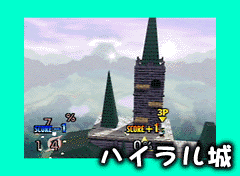 |
 |
- It had a very different background.
| Prerelease Image |
In-game |
|---|
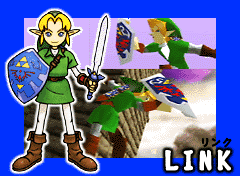 |
 |
- It was probably going to take place at dawn or sunset. However, this is the only image showing the stage like that, so it is possible that the picture was taken before the others.

Yoshi's Island
| Prerelease Image |
In-game |
|---|
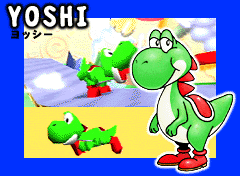 |
 |
- The Super Happy Tree, and the orange and blue colored clouds in the background were much smaller.
- The floating platforms didn't have textures below them.
Dream Land
| Prerelease Image |
In-game |
|---|
 |
 |
- The patches of tullip-looking flowers were redesigned to resemble sunflowers.
- The bushes with pink flowers were originally darker and had orange flowers.
- Whispy Woods' leaves were much darker.
- Patches of bushes in the background were changed to fences.
- It had a different background.
- The small bodies of water used different textures.
- The bark in the floating wooden planks was darker. The texture looks very similar to the one used in the two unused stages.
Saffron City
| Prerelease Image |
In-game |
|---|
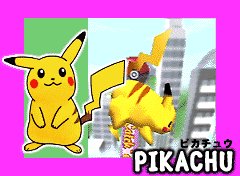 |
 |
- The colors of the main building's rooftop were purple and pink, but they were changed to gray and a lighter tone of purple respectively.
- The left building had a green rooftop that was changed to a gray.
- The building holding the "Got a Catch 'em All!" banner was much smaller and had a white rooftop with black windows covering the walls, but it was changed to a bigger, green building.
- The "Got a Catch 'em All!" banner was pink with a white stripe in it, but it was changed to green with a pink stripe in the middle and two white stripes.
- The building on the right didn't have a helipad and originally stood in the background, in front of the building holding the banner.
- The hovering platforms were black with a brown top. They were changed to gray.
Character Selection Screen
| Prerelease Image |
In-game |
|---|
 |
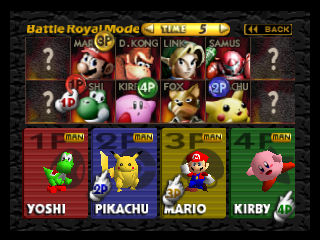 |
- Icons for unlockable characters that were not unlocked had a simpler design of blue, green, red and yellow-colored squares with a black question mark in the middle, but were replaced with gray silhouettes with a white question mark in the middle.
- The yellow bar with the stock count or time limit of the next match had "TIMER" written in it when the match was a Time match, but it was changed to "TIME".
- A counter of how many "MAN" (human controlled) and "COM" (computer controlled) players there were in the character selection screen of VS Mode was replaced with the "BACK" option.
- For some reason, Yoshi has a shadow on his snout.
| Prerelease Image |
In-game |
|---|
 |
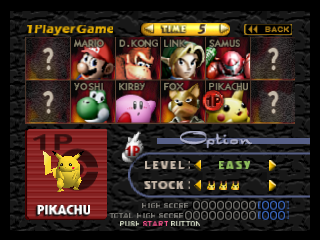 |
- It lacked the "BACK" option.
- The font used in "1 Player Game" was changed and the spacing between words was removed.
- The color used in "EASY" is blue instead of green. The very easy option uses this color instead.
- The display for total high score is absent.
- There are seven digits in the high score display instead of eight.
- The "Option" menu is bigger.
- The blue counter next to the high score display has parentheses that were changed to brackets around it and has two digits instead of three
Intro
- Yoshi would have stand prone.
- Different square colors for Kirby and some others.
- No character pose on those squares (except Link and Yoshi, but they were slightly moved).
- Brinstar had a different background???
Series Symbols
| Prerelease |
In-game |
|---|
 |
 |
- The Legend of Zelda's series symbol was an upside-down piece of the Triforce, likely inspired by the Triforce of Courage shown in Link's hand before the battle with Ganondorf in The Legend of Zelda: Ocarina of Time. It was changed to the full Triforce.
| Prerelease |
In-game |
|---|
 |
 |
- Yoshi's series symbol lacked the spots in the Egg, being a simple oval shape.
Items
- The Crate lacked the Super Smash Bros. symbol on its side.
- The Bumper's colors were changed. It had a cyan outline that was recolored to dark blue, and the yellow symbol in the center was slightly darkened. This can be seen in an image showing the floating Bumper in Peach's Castle.
Dropped Ideas (change that, please)
Fan E-mail Answers
- Mewtwo, Bowser, and King Dedede were supposed to have been playable characters in this game, but they aren't due to time restrictions. They are playable in other games of the series, and King Dedede also appears in Dream Land's background. (1, H.T さん; 3, 頭方腐敗 さん)
- Split-screen was a concept, but the director was against it because he wanted all characters to be in the same screen and it would be difficult to see the game's action. (3, Y.Y さん)
- The Legend of Zelda: Ocarina of Time was in development simultaneously with Super Smash Bros., and because of the developers' lack of information, Link has the Boomerang, despise that he can't use this item in his adult age in that game. (11, いずこ さん)
- Giant Donkey Kong and Metal Mario were used to test the game during its development. (3, T.F さん)
- Pressing Z would make Link to protect himself with his Hylian Shield, but it had to be cut for unknown reasons. It can block projectiles that have contact with it in other games of the series. (6, M さん)
Dummy
- Super Smash Bros. was tentatively titled Smash Brothers.
- On an article previewing Super Smash Bros. at IGN, it is mentioned that the game would feature Peach in some form.
- The congratulatory screens shown after completing 1P Game do not exist at all within the Japanese version, but they were planned to have been implemented in this version of the game. (am I really sure of that?)
- Final Smashes and Smash Balls were intended to have been introduced since this game, but this concept was planned even earlier. Voices and sounds were recorded for this feature, and leftovers of this feature can be found in the system debug menu, and some of them are used unaltered in Super Smash Bros. Brawl, which is where this feature was implemented.
- Only fire, electric, sword slashes and normal effects can be produced from attacks, but an ice effect was planned, despite not being any ice-based attack on the game. This effect is featured in other games of the series.
Add theses images
